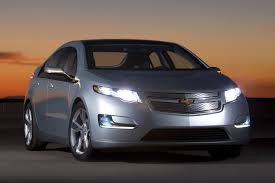Can Plug-in Hybrid Electric Vehicles (PHEV), such as the Holden (GM-Chevrolet) Volt, make a difference to emissions in Australia? In the USA, 24,359 PHEVs – including 7,067 Volts – were sold in the first half of 2014, representing 54% of BEV&PHEV sales and 0.55% of all car sales. In some European countries, such as Norway, 15% of all new car sales are already BEV/PHEV. To date, 223 Volts and 469 Mitsubishi Outlander PHEVs have been sold in Australia.
 Unlike the Nissan Leaf which runs exclusively on battery (Battery EV or BEV), the PHEV is a versatile class of hybrid electric vehicles that can run on battery only (charged by plugging into a wall-socket) but which can also run on charge generated by a small, on-board, petrol engine, re-charging the battery, if required, as the vehicle moves.
Unlike the Nissan Leaf which runs exclusively on battery (Battery EV or BEV), the PHEV is a versatile class of hybrid electric vehicles that can run on battery only (charged by plugging into a wall-socket) but which can also run on charge generated by a small, on-board, petrol engine, re-charging the battery, if required, as the vehicle moves.
The beauty of the PHEV is that it doesn’t suffer from the limitations of pure electric vehicles. In normal use, the Volt can travel around 80km on a charge. The smart option is to charge it daily, like a smartphone. However, if the charge is insufficient for a driver’s needs, the petrol generator can keep the vehicle going to the next electric plug or to the service station for more petrol. This capability avoids a major obstacle to BEV take-up, i.e. anxiety about range. It also makes the vehicle independent of charging infrastructure away from home.
Since most people don’t do more than 80km a day very often, a PHEV such as the Volt can run exclusively on electricity most of the time.
But what about the emissions from the coal burned to produce that electricity? Are those worse than petrol emissions?
In Victoria, there’s a not much difference between emissions from charging using brown coal and petrol (both around 250g/km). However in other states, grid electricity generally produces significantly lower emissions than petrol/diesel due to the use of less-polluting black coal (e.g. NSW), a mix of significant amounts of windpower/solar (especially SA, Qld and ACT), or mostly hydro (especially Tasmania).
If a driver has solar panels at home and can charge their vehicle from those panels (off-street parking required), they can re-charge their PHEV emissions-free. That’s a lot better than petrol which produces between 90 grams (Toyota Prius Hybrid) up to 300 grams of CO2 per km, depending on car, engine, driving conditions and so on.
For the PHEV owner without PV, Australia offers the GreenPower system. Buying 100% GreenPower from an electricity retailer ensures that the electricity put into the EV is 100% emissions-free.
What impact could a car run on emissions-free electricity make to Australian emissions? A PHEV run on 100% GreenPower 90% of the time and doing the national average distance per annum (15,000 km/year) would avoid producing 3,000-4,000 kg of emissions, compared with an equivalent petrol vehicle.
The PHEV offers the advantages of eliminating “range anxiety” and avoiding the need to wait for public charging infrastructure, thus avoiding the chicken/egg dilemma facing BEV owners, manufacturers and funders.
A variety of potential issues still make the PHEV unsuitable for some drivers, such as no place to re-charge at home or a need to regularly drive longer distances between re-charges.
Currently Australia produces 540 million tonnes of greenhouse gas per year. Transport contributes 100 million tonnes of the total.
If 5% of vehicle stock in Australia were PHEVs, their use could result in substantial reductions in transport emissions – around 4.5 million tonnes/year, assuming 90% battery use.
Another potential benefit of the PHEV (and BEV) is to the electricity industry. Demand for electricity is falling in Australia and generators have a serious problem with over-supply of electricity at night (when they sell it very cheaply). PHEVs plugging in overnight could increase demand for electricity and solve some serious problems for the generators, distributors and retailers.
However, while PHEV technology is ready, the cost of PHEVs is still on the early stages of the commercialization cost-curve (the Volt costs $60,000 in Australia; the Mitsubishi Outlander PHEV costs $48,000) and lack of awareness by business and the public means that it could be a while before PHEVs produce significant impact on emissions.










